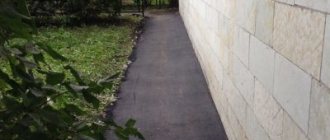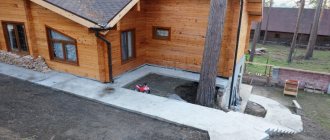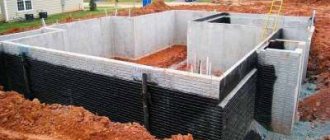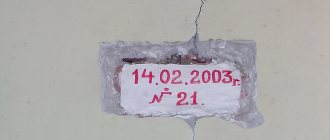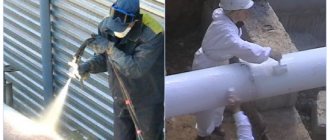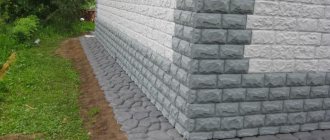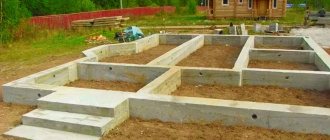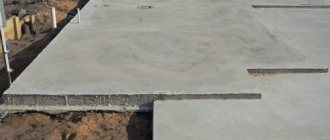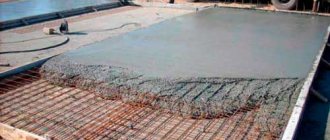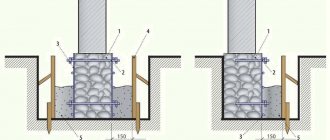What is a blind area
Many people paid attention to the attractive path that encircles the building. It consists of the following layers:
- external It is a special, decorative coating made from various materials. Located on a slope. It has increased insulating characteristics and is hermetically sealed with the outside of the basement or the foundation of the building. The outer layer makes it difficult for moisture to access the joint areas and the part of the foundation located below the zero level;
- internal. It is formed in a pre-prepared pit around the perimeter of the building. It consists of a compacted sand-crushed stone cushion, reinforcing reinforcement frame, concrete and thermal insulation flooring. All layers of the substrate are performed sequentially and, after final hardening of the concrete composition, form the basis for the finishing coating. The substrate protects the soil from swelling.
A blind area is an element of a building that reduces the load on the waterproofing of the foundation
A horizontally located protective strip made around the building has the following characteristics
:
- increased strength;
- thermal insulation properties;
- moisture resistance;
- tightness.
Some consider such a path to be a decorative element, but it performs a number of protective functions.
It's simple - Blind area made of paving slabs, asphalt and others || STROIM-GRAMOTNO.RU
For anyone, one of the main enemies is water: it is considered maximum on structures of wood, concrete, even stone. Therefore, at the stages of construction, waterproofing, water systems from the roof, and the foundation is important. To protect the outer part from rain flood flows, use different blind areas around
The choice depends :
- type
- ground heights
- financial capabilities;
- use the blind area as a surrounding walking path.
blind area around
To drain water from or the base, use the most types of structures. can be classified on different grounds. So, the blind area can be:
- Simple complex design Complex ones have three layers, deepening and are part of the sewerage system of the building area around
- With artificial, all rolled, and waterproofing or without. In some cases, with practically soil, both one of the layers can be equipped.
- With (hard blind area) absence of (soft) layer . the insulation is reliable and at the same time financial and costly.
- With types of exterior finishing . number of options: tiles, concrete asphalt, porcelain tiles, stone and so on.
- Hidden open . it is necessary that there is at the same time a path around it, it must be completely hidden by a layer of turf, its presence
When choosing the type of blind area at home, you need not only the aspect of the issue, but also reliability and aesthetics.
Of all types, concrete ones are considered the most justified, repairable and durable. At the same time, making the design very
You will have to go through the following steps :
- a trench 30 centimeters deep. The width is chosen so that water flows into the ground and enters the system, which is in the blind area. provide a slope of less than 5° in the direction from for drainage
- We line the bottom with geotextile film, bulk materials go into
- The bottom must be sprinkled with gravel or a medium module with a layer thickness of 3–5 cm.
- You should put a 7-10 centimeter layer of wet sand and compact it thoroughly.
- there is a layer that should not only but also cover part of the building.
- The walls of the pit are supported - created for the future from concrete.
- wall of the building material for expansion joints is about 2.5 You can use boards or vinyl based. Not about the deformation between the house and the blind area.
- We make a screed, you can use a horizontal screed. Near the house, the screed should be higher than the edges, approximately 10 centimeters, to create a slope for the water flow.
- Waterproof the resulting seams on the surface.
This type of work around the house is the most labor-intensive and requires certain skills.
For pouring around the house, use grades M250–400 with frost resistance and the proportion of concrete grade M300 cement grade is mixed with dry cement and crushed stone of the following proportion. Next, add to make 40 liters for pouring
What to cover
The outer layer can be made in any way.
You can divide the materials for the following :
- low crushed stone, sand, and so on
- medium: asphalt, bare concrete with a waterproofing layer;
- tiles, porcelain stoneware, stone.
In fact, an asphalt blind area is no different from a concrete one, except that it is so durable and somewhat cheaper. for these two it's rarely complicated. She is one of the following :
- sandy clay substrate, poured into the trench (made with a slope away from
- curb stones to the outer perimeter
- compacted crushed stone brick, gravel, etc.);
- (don't forget the expansion joints).
Carrying out waterproofing can be considered one of the most types of blind areas of the house as complete.
blind area
A blind area in which the materials and subsurface are not filled in is filled up is called a blind area. The outside can be made of stone, crushed stone, and other materials. If it is done shallowly, most often it happens), then take into account several :
- carefully choose a waterproofing material - it will be strong and durable;
- do not place the edge on the foundation
- take into account that similar species around the house are made from scrap materials, so that they are washed away into layers, there is good geotextile;
- layers need to be compacted.
If all these problems arise, water drainage will arise.
Tiles for the blind area of the house
Paving slabs are excellent as a decorative blind area. You can lay a concrete base, which is optimal, or a soft blind area.
in the second case, the tile blind area will be one of the following
- sand;
- waterproofing;
- or gravel;
- one sandy
- tile adhesive;
- tile.
When finished, the seams must be sanded down to allow water to penetrate the lower layers.
Owners often decide the type of blind area for their home based on economic opportunities. for an inexpensive country house, soft is suitable for an elite one - solid
It is important not to make a good slope (do not overdo it, do not slide on this path in winter), and also include it in the general drainage system.
Why is the blind area of the building carried out according to SNiP?
The protective structure is created to solve a complex of serious problems:
- protecting the basement of the building from the effects of precipitation;
- ensuring the integrity of the foundation of the structure;
- additional thermal insulation of the basement;
- protecting the soil from freezing;
- protecting the foundation of the building from destruction by roots;
- reducing the cost of foundation restoration;
- preventing soil heaving;
- effective removal of precipitation.
As with any structural element, it has special requirements that must be met.
In addition, the blind area provides the following functions:
- ease of movement around the building;
- attractive appearance of the building.
The functional purpose of the protective structure is ensured provided that its dimensions are respected.
What determines the width of the blind area according to SNiP
The specified parameter is determined by calculation taking into account the following factors:
- soil type;
- location of the roof edge;
- features of the building.
One of the parameters affecting the width of the protective area is the degree of soil subsidence, which is determined in the laboratory.
The element is designed to remove excess moisture outside the perimeter of the house
Building codes classify soils into the following types:
- soils that are resistant to deformation under the influence of their own mass. They sag under the influence of external forces by no more than 50 mm;
- soils susceptible to shrinkage under the influence of their own weight. Deformation exceeds 50 mm under the influence of external loads.
The width of the protective contour, depending on the type of soil, is:
- more than 150 cm – for the first group;
- above 200 cm - for the second type.
The soil type is determined based on reference sources or by performing a comprehensive analysis.
Minimum blind area width
Current regulatory documents regulate the minimum permissible width of the blind area. It is 80–100 cm. Please note that the specified size must exceed the location of the edge of the roof by 20–30 cm. Compliance with this requirement guarantees effective drainage, provided that the optimal slope of the surface in the direction opposite to the building is observed.
It is necessary to take into account the dimensions of the building, as well as the distance between adjacent buildings. Excessively narrow edging can visually disrupt the proportions and overall exterior.
A blind area made of paving slabs, cobblestones or clay can fit perfectly into the design of a garden or summer cottage
Thickness Requirements
Depending on what brand of concrete is used for the blind area, SNiP allows for different thicknesses of the blind area.
The total thickness of the protective path around the perimeter of the building is determined by summing the following values:
- thickness of the sand cushion;
- height of the gravel layer;
- depth of the concrete base.
To construct a blind area, it is necessary to remove a layer of soil to a depth of about 20–30 cm and form a cushion 50–150 mm thick. The minimum elevation of the outer part of the path above the soil level is 5 cm. The thickness of the protective platform increases towards the house in accordance with the accepted slope.
How to properly fill an asphalt concrete blind area
Making a blind area is not difficult, but naturally you need to know the construction of an asphalt concrete blind area step by step, so that later the path around the house will be durable and fulfill its functions. Stages of laying a blind area made of asphalt concrete:
- We dig a trench up to 30 cm. We compact the soil well;
- We put sand or clay at the bottom, this is a kind of substrate so that the bulk material does not go into the soil;
- We lay out curb stones along the outer perimeter of the ditch;
- Next, pour gravel and crushed stone, medium in size. The layer thickness should be up to 15 cm.
- Asphalt rolls out from above. The thickness of this layer is up to 5 cm.
That's all, you now know the construction of an asphalt concrete blind area.
But it is necessary not to forget about the most important point; the slope of this structure is required so that the water flows into special drains. The angle should be 3-5 degrees from the wall of the house.
And the width of the trench is chosen taking into account that water does not fall on the soil, but on the blind area, but not less than 15-29 cm from the roof overhang.
After reading this article, you now know what a blind area made of asphalt concrete should be, what nuances you need to pay attention to, and most importantly, that it is unnecessary to neglect the construction of this important external element of any building.
More on this topic on our website:
- We estimate the cost of arranging a concrete blind area. The foundation blind area serves to protect the house from moisture and freezing. A correctly and neatly laid blind area is also a decorative element of the house. The absence of a blind area is fraught with erosion of the foundation...
- How much does it cost to fill a blind area around a house? In order for the blind area to serve for a long time, truly protect the house and provide drainage, its production is best entrusted to professionals. Only they can choose high-quality durable material...
- Making a blind area around the well The main element of the arrangement is the blind area around the well. It will not allow melted snow and surface water to enter the mine, and will also provide a convenient approach to the structure...
- The blind area around the house in section - see the drawing The blind area is a structural link of the building, which carries several important functions: decoration, protection, thermal insulation and practicality....
SNP blind area device
The algorithm for constructing a blind area involves performing the following operations:
- Cleaning the soil along the building's contours from debris and vegetation.
- Extraction of soil to a given depth and construction of formwork.
- Backfilling the gravel-sand cushion and compacting it.
- Installation of reinforcing mesh and pouring concrete mortar.
If necessary, a layer of thermal insulation can be installed before concreting.
The concrete base can be decorated in an original way with finishing materials. When performing work, the requirements of building codes must be observed, which ensures the durability of the structure and reliable protection of the foundation.
What is asphalt concrete
Asphalt concrete is a man-made material that is made by mixing organic and mineral elements. All of them are thoroughly mixed and hardened. Gravel or crushed stone can be used as mineral materials.
Asphalt concrete is an irreplaceable material that allows you to make strong floors in industrial buildings, roads, airfield pavements, etc. Asphalt concrete pavement is the best solution for owners of private houses.
Advantages of asphalt concrete pavement around the perimeter of the house
The material is considered the most financially profitable and is used for various purposes throughout Russia. If necessary, it can be repaired in the future without any problems. The material and finished design will have a long service life.
A blind area made of high-quality asphalt will reliably protect the foundation and building from the harmful effects of moisture, fungi and other troubles.
